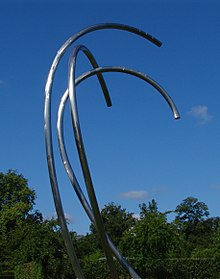Beate Schroedl-Baurmeister




Beate Schroedl-Baurmeister (* 1953) is a german sculptor.
Education[edit]
Beate Schroedl-Baurmeister grew up in Bamberg and later studied art with the emphasis on sculpture in the class of Rudolf Hoflehner at the College of Fine Arts in Stuttgart from 1972 to 1978. Parallel to this she studied art history and sociology at the University of Stuttgart. After her first state examination she became a pupil of the sculptor Joachim_Schmettau at the College of Fine Arts in Berlin from 1978 to 1983. After a three-year postgraduate course, she completed her studies with the second state examination in 1985.
For three years she had a state-funded residency in the Senate studios Käuzchensteig in Berlin-Dahlem, today the Kunsthaus Dahlem. She has resided in Wuppertal, NRW, since 1988 and maintains her workshop and studio there. In 2003 she was awarded the Lorenzo il Magnifico Prize at the 4th Biennale of Contemporary Art in Florence. She created the sculpture Schwung, which has been presented annually since 2003 as an award to the winners of the Wuppertal Economics Prize.
Works[edit]
Characteristic of Beate Schroedl-Baurmeister is that she works in groups of works. She is dedicated to two overarching themes: people and nature. She is known for her abstract stainless-steel sculptures, some of which are six meters high. She discovered steel as a material early on. She develops her ideas by shaping models for later enlargements.
At the beginning of her artistic work, the focus was on figures and heads, and she worked predominantly in plaster and ceramics. Their formal language became increasingly abstract and reduced. She interprets the human body through lines and arcs and focuses on aspects of movement. Since 1999 she has been developing a series of works and installations based on motifs from nature. She reduces grasses to their basic formal structures and transfers the resulting sculptural idea to her preferred material, stainless steel. The grasses and stalks that seem to bend in the wind serve as a metaphor for society reacting to new challenges without breaking. Her sculptures always relate to the outdoors and resonate with the landscape, such as the blades of grasses which she conceived and exhibits for the Asia Garden Dyck Castle near Jüchen, NRW.
Since 2007 she has also focused on urban spaces, integrating motifs from nature into an urban environment.
Over and above, she got to know dancers from the Pina Bausch dance theatre in Wuppertal; her work "Momentum" displayed in the Art biennale Venice 2024 is one of a series of works that evolved out of this exposure to modern dance. The sculpture may be interpreted as a metaphor for the dynamic and kinetic energy of dancers or of a society in transition.
International exhibitions[edit]
- 2024: Art Biennale, Venice, Italy
- 2009: Swiss Triennale of Sculpture, Bad Ragaz und Vaduz
- 2004 – 2010: Gallery Hannah Peschar Sculpture Garden, UK
- 2006: Austrian Art Biennale, Klagenfurt
- 2003: Biennale of Contemporary Art, Florence, Italy
- 1997: National Gallery of Contemporary Art, Bucharest, Romania
Weblinks[edit]
